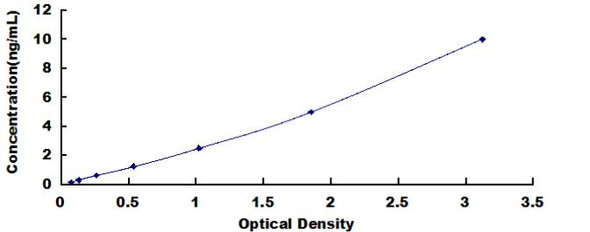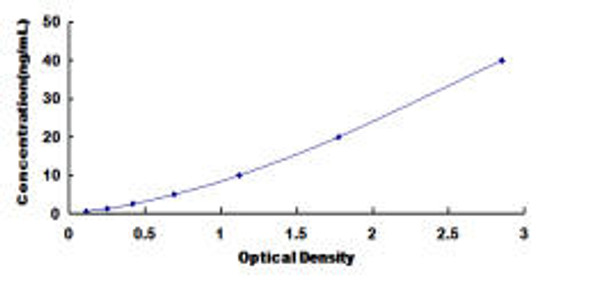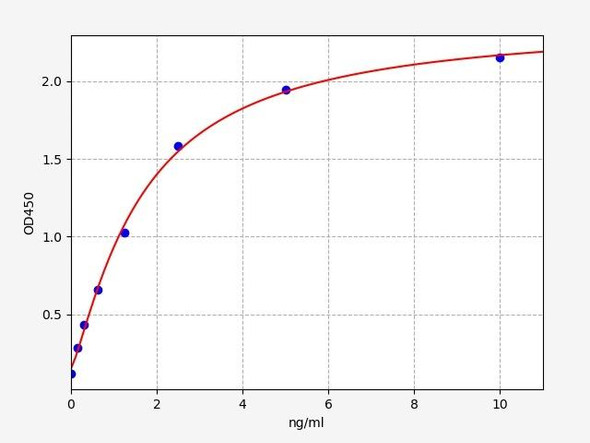Human CPR (Cytochrome P450 Reductase) ELISA Kit (HUES01577)
- SKU:
- HUES01577
- Product Type:
- ELISA Kit
- Size:
- 96 Assays
- Uniprot:
- P16435
- Sensitivity:
- 0.09ng/mL
- Range:
- 0.16-10ng/mL
- ELISA Type:
- Sandwich
- Synonyms:
- POR, CYPOR, P450R, NADPH:ferrihemoprotein oxidoreductase, NADPH:hemoprotein oxidoreductase, NADPH:P450 oxidoreductase
- Reactivity:
- Human
- Sample Type:
- Serum, plasma and other biological fluids
- Research Area:
- Cell Biology
Description
Human CPR (Cytochrome P450 Reductase) ELISA Kit
The Human CPR (Cytochrome P450 Reductase) ELISA Kit is designed for the precise measurement of CPR levels in human samples including serum, plasma, and cell culture supernatants. This kit offers exceptional sensitivity and specificity, ensuring accurate and consistent results for various research purposes.CPR, also known as Cytochrome P450 Reductase, plays a vital role in electron transfer processes within the cytochrome P450 system, crucial for drug metabolism and detoxification in the liver.
Understanding CPR levels can provide valuable insights into drug efficacy, toxicity, and drug-drug interactions, making it a key biomarker for pharmaceutical research and clinical studies.Whether studying liver function, drug metabolism, or investigating potential drug candidates, the Human CPR ELISA Kit is a reliable tool for researchers looking to explore the intricate mechanisms of the P450 system and its implications in human health and disease.
| Assay type: | Sandwich |
| Format: | 96T |
| Assay time: | 4.5h |
| Reactivity: | Human |
| Detection Method: | Colormetric |
| Detection Range: | 0.16-10 ng/mL |
| Sensitivity: | 0.10 ng/mL |
| Sample Volume Required Per Well: | 100µL |
| Sample Type: | Serum, plasma and other biological fluids |
| Specificity: | This kit recognizes Human CPR in samples. No significant cross-reactivity or interference between Human CPR and analogues was observed. |
This ELISA kit uses Sandwich-ELISA as the method. The micro ELISA plate provided in this kit has been pre-coated with an antibody specific to Human CPR. Standards or samples are added to the appropriate micro ELISA plate wells and combined with the specific antibody. Then a biotinylated detection antibody specific for Human CPR and Avidin-Horseradish Peroxidase (HRP) conjugate are added to each micro plate well successively and incubated. Free components are washed away. The substrate solution is added to each well. Only those wells that contain Human CPR, biotinylated detection antibody and Avidin-HRP conjugate will appear blue in color. The enzyme-substrate reaction is terminated by adding Stop Solution and the color turns yellow. The optical density (OD) is measured spectrophotometrically at a wavelength of 450 nm ± 2 nm. The OD value is proportional to the concentration of Human CPR. The concentration of Human CPR in samples can be calculated by comparing the OD of the samples to the standard curve.
| UniProt Protein Function: | POR: This enzyme is required for electron transfer from NADP to cytochrome P450 in microsomes. It can also provide electron transfer to heme oxygenase and cytochrome B5. Defects in POR are the cause of Antley-Bixler syndrome with genital anomalies and disordered steroidogenesis (ABS1). A disease characterized by the association of Antley-Bixler syndrome with steroidogenesis defects and abnormal genitalia. Antley-Bixler syndrome is characterized by craniosynostosis, radiohumeral synostosis present from the perinatal period, midface hypoplasia, choanal stenosis or atresia, femoral bowing and multiple joint contractures. Defects in POR are the cause of disordered steroidogenesis due to cytochrome P450 oxidoreductase deficiency (DISPORD). A disorder resulting in a rare variant of congenital adrenal hyperplasia, with apparent combined P450C17 and P450C21 deficiency and accumulation of steroid metabolites. Affected girls are born with ambiguous genitalia, but their circulating androgens are low and virilization does not progress. Conversely, affected boys are sometimes born undermasculinized. Boys and girls can present with bone malformations, in some cases resembling the pattern seen in patients with Antley-Bixler syndrome. |
| UniProt Protein Details: | Protein type:EC 1. 6. 2. 4; Endoplasmic reticulum; Mitochondrial; Oxidoreductase Chromosomal Location of Human Ortholog: 7q11. 2 Cellular Component: endoplasmic reticulum membrane; intracellular membrane-bound organelle; membrane Molecular Function:[methionine synthase] reductase activity; NADPH-hemoprotein reductase activity; protein binding Biological Process: positive regulation of monooxygenase activity; xenobiotic metabolic process Disease: Antley-bixler Syndrome With Genital Anomalies And Disordered Steroidogenesis; Antley-bixler Syndrome Without Genital Anomalies Or Disordered Steroidogenesis; Disordered Steroidogenesis Due To Cytochrome P450 Oxidoreductase Deficiency |
| NCBI Summary: | This gene encodes an endoplasmic reticulum membrane oxidoreductase with an FAD-binding domain and a flavodoxin-like domain. The protein binds two cofactors, FAD and FMN, which allow it to donate electrons directly from NADPH to all microsomal P450 enzymes. Mutations in this gene have been associated with various diseases, including apparent combined P450C17 and P450C21 deficiency, amenorrhea and disordered steroidogenesis, congenital adrenal hyperplasia and Antley-Bixler syndrome. [provided by RefSeq, Jul 2008] |
| UniProt Code: | P16435 |
| NCBI GenInfo Identifier: | 2851393 |
| NCBI Gene ID: | 5447 |
| NCBI Accession: | P16435. 2 |
| UniProt Related Accession: | P16435 |
| Molecular Weight: | |
| NCBI Full Name: | NADPH--cytochrome P450 reductase |
| NCBI Synonym Full Names: | cytochrome p450 oxidoreductase |
| NCBI Official Symbol: | POR |
| NCBI Official Synonym Symbols: | CPR; CYPOR; P450R |
| NCBI Protein Information: | NADPH--cytochrome P450 reductase |
| UniProt Protein Name: | NADPH--cytochrome P450 reductase |
| Protein Family: | Pyruvate synthase |
| UniProt Gene Name: | POR |
| UniProt Entry Name: | NCPR_HUMAN |
As the OD values of the standard curve may vary according to the conditions of the actual assay performance (e. g. operator, pipetting technique, washing technique or temperature effects), the operator should establish a standard curve for each test. Typical standard curve and data is provided below for reference only.
| Concentration (ng/mL) | O.D | Average | Corrected |
| 10 | 2.314 2.366 | 2.34 | 2.264 |
| 5 | 1.496 1.55 | 1.523 | 1.447 |
| 2.5 | 0.873 0.857 | 0.865 | 0.789 |
| 1.25 | 0.425 0.453 | 0.439 | 0.363 |
| 0.63 | 0.275 0.255 | 0.265 | 0.189 |
| 0.32 | 0.169 0.167 | 0.168 | 0.092 |
| 0.16 | 0.123 0.125 | 0.124 | 0.048 |
| 0 | 0.069 0.083 | 0.076 | -- |
Precision
Intra-assay Precision (Precision within an assay): 3 samples with low, mid range and high level Human CPR were tested 20 times on one plate, respectively.
Inter-assay Precision (Precision between assays): 3 samples with low, mid range and high level Human CPR were tested on 3 different plates, 20 replicates in each plate.
| Intra-assay Precision | Inter-assay Precision | |||||
| Sample | 1 | 2 | 3 | 1 | 2 | 3 |
| n | 20 | 20 | 20 | 20 | 20 | 20 |
| Mean (ng/mL) | 0.51 | 1.03 | 3.69 | 0.48 | 1.13 | 3.81 |
| Standard deviation | 0.03 | 0.05 | 0.19 | 0.03 | 0.06 | 0.12 |
| C V (%) | 5.88 | 4.85 | 5.15 | 6.25 | 5.31 | 3.15 |
Recovery
The recovery of Human CPR spiked at three different levels in samples throughout the range of the assay was evaluated in various matrices.
| Sample Type | Range (%) | Average Recovery (%) |
| Serum (n=5) | 91-104 | 96 |
| EDTA plasma (n=5) | 95-110 | 101 |
| Cell culture media (n=5) | 89-99 | 94 |
Linearity
Samples were spiked with high concentrations of Human CPR and diluted with Reference Standard & Sample Diluent to produce samples with values within the range of the assay.
| Serum (n=5) | EDTA plasma (n=5) | Cell culture media (n=5) | ||
| 1:2 | Range (%) | 98-110 | 98-112 | 95-106 |
| Average (%) | 103 | 104 | 100 | |
| 1:4 | Range (%) | 92-105 | 82-96 | 86-98 |
| Average (%) | 98 | 88 | 92 | |
| 1:8 | Range (%) | 88-102 | 81-95 | 88-102 |
| Average (%) | 95 | 87 | 95 | |
| 1:16 | Range (%) | 91-106 | 82-93 | 87-99 |
| Average (%) | 97 | 87 | 93 |
An unopened kit can be stored at 4°C for 1 month. If the kit is not used within 1 month, store the items separately according to the following conditions once the kit is received.
| Item | Specifications | Storage |
| Micro ELISA Plate(Dismountable) | 8 wells ×12 strips | -20°C, 6 months |
| Reference Standard | 2 vials | |
| Concentrated Biotinylated Detection Ab (100×) | 1 vial, 120 µL | |
| Concentrated HRP Conjugate (100×) | 1 vial, 120 µL | -20°C(shading light), 6 months |
| Reference Standard & Sample Diluent | 1 vial, 20 mL | 4°C, 6 months |
| Biotinylated Detection Ab Diluent | 1 vial, 14 mL | |
| HRP Conjugate Diluent | 1 vial, 14 mL | |
| Concentrated Wash Buffer (25×) | 1 vial, 30 mL | |
| Substrate Reagent | 1 vial, 10 mL | 4°C(shading light) |
| Stop Solution | 1 vial, 10 mL | 4°C |
| Plate Sealer | 5 pieces | |
| Product Description | 1 copy | |
| Certificate of Analysis | 1 copy |
- Set standard, test sample and control (zero) wells on the pre-coated plate and record theirpositions. It is recommended to measure each standard and sample in duplicate. Note: addall solutions to the bottom of the plate wells while avoiding contact with the well walls. Ensuresolutions do not foam when adding to the wells.
- Aliquot 100 µL of standard solutions into the standard wells.
- Add 100 µL of Sample / Standard dilution buffer into the control (zero) well.
- Add 100 µL of properly diluted sample (serum, plasma, tissue homogenates and otherbiological fluids) into test sample wells.
- Cover the plate with the sealer provided in the kit and incubate for 90 min at 37 °C.
- Aspirate the liquid from each well, do not wash. Immediately add 100 µL of BiotinylatedDetection Ab working solution to each well. Cover the plate with a plate seal and gently mix. Incubate for 1 hour at 37 °C.
- Aspirate or decant the solution from the plate and add 350 µL of wash buffer to each welland incubate for 1-2 minutes at room temperature. Aspirate the solution from each well andclap the plate on absorbent filter paper to dry. Repeat this process 3 times. Note: a microplatewasher can be used in this step and other wash steps.
- Add 100 µL of HRP Conjugate working solution to each well. Cover with a plate seal andincubate for 30 min at 37 °C.
- Aspirate or decant the solution from each well. Repeat the wash process for five times asconducted in step 7.
- Add 90 µL of Substrate Reagent to each well. Cover with a new plate seal and incubate forapproximately 15 min at 37 °C. Protect the plate from light. Note: the reaction time can beshortened or extended according to the actual color change, but not by more than 30min.
- Add 50 µL of Stop Solution to each well. Note: Adding the stop solution should be done inthe same order as the substrate solution.
- Determine the optical density (OD value) of each well immediately with a microplate readerset at 450 nm.










